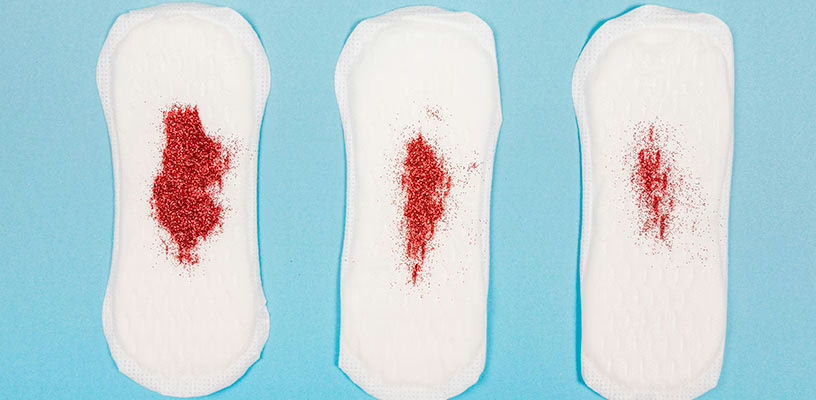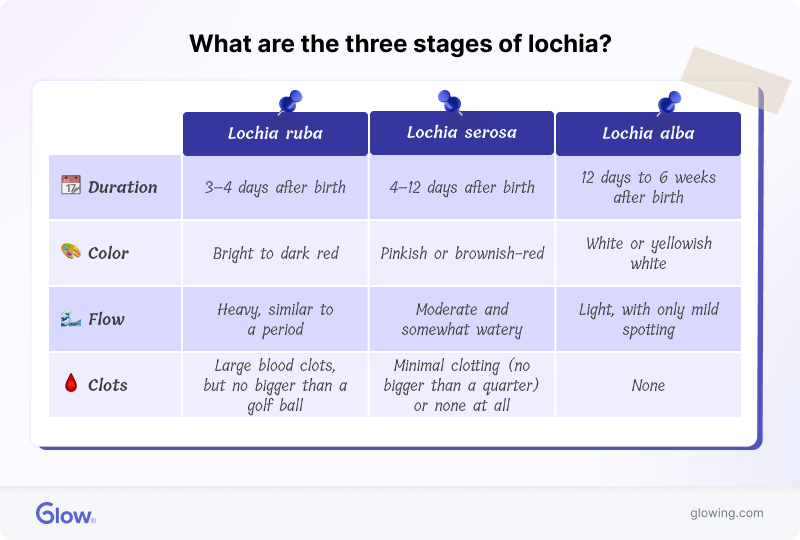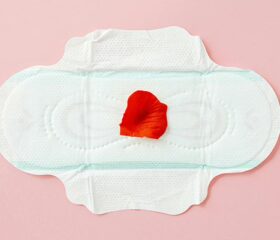Understanding Postpartum Bleeding (Lochia): How Long It Lasts and When to See a Doctor
Congratulations on your new baby! While you're preparing to navigate the highs and lows of the "fourth trimester”—sleepless nights, diaper changes, and lots of cooing at your cute little one—your body is undergoing many important changes.

One of the most common postpartum experiences is lochia, which is vaginal bleeding after birth. Although bloody discharge looks alarming, it’s usually completely normal. Read on to learn more about what it is, why you’re seeing it, and how to tell if there’s an issue with it that means you should see a doctor.
What is lochia?
Lochia is a kind of discharge that your body produces after you give birth. In contrast to discharge during pregnancy, which helps you prepare for childbirth, lochia is your body’s way of flushing out all the leftover blood, mucus, and uterine tissue from your pregnancy. 1 Think of it as your uterus shedding the lining it no longer needs, similar to what happens during your menstrual cycle.
Lochia is a universal experience for recent mothers, whether they had a vaginal delivery or a C-section. You may experience some mild cramping two to three days after delivery as your uterus works to expel the tissue and shrink back to its original size. 2

How long does postpartum bleeding last?
After you give birth, you may experience lochia for about 6 weeks. 3 Don’t mistake it for your first period after pregnancy—that will come later.
On that note, try not to worry if your period doesn’t return right away after your pregnancy concludes. Even after lochia ceases, it may take a while for your menses to resume, particularly if you’re frequently breastfeeding (which can delay its return).
What your lochia will be like
Your flow may initially be heavier—enough to soak through a thick maxi pad in two to three hours. It should lessen over the next few days. 4 Your flow may be lighter if you had a C-section. 5
Don’t be surprised if you see blood clots in your lochia, which may be around the size of grapes or even small tomatoes. 6 As you heal, the clots should get smaller and smaller. Contact your doctor if they don’t or you’re otherwise concerned about their size.
What are the three stages of lochia?
Every woman experiences lochia differently, but you can generally expect three distinct stages: 7
| Stage | Duration | Color | Flow | Clots |
|---|---|---|---|---|
| Lochia ruba | 3–4 days after birth | Bright to dark red | Heavy, similar to a period | Large blood clots, but no bigger than a golf ball |
| Lochia serosa | 4–12 days after birth | Pinkish or brownish-red | Moderate and somewhat watery | Minimal clotting (no bigger than a quarter) or none at all |
| Lochia alba | 12 days to 6 weeks after birth | White or yellowish white | Light, with only mild spotting | None |
How can you manage your postpartum bleeding?
Your first few days of lochia may be intense, so be prepared. The hospital will provide you with large, absorbent pads, but you’ll want to stock up on extras, just in case. You should also wear clothes that you don’t mind staining (disposable underwear and pants can be a lifesaver here).
To maintain proper hygiene, avoid using tampons, as they can introduce bacteria to your healing uterus and cause infection. 8 Instead, wear pads and change them as frequently, as needed.
Your doctor may also offer you a peri bottle (portable squeeze bottle) that acts as a handheld bidet. You can use this to clean the area between your vagina and anus (the perineal area), especially if you have stitches or tearing that would otherwise make this difficult to do hygienically. 9
While you recover, drink plenty of water to help your body along. You should try to get about 16 cups daily when you’re nursing. 10
When should you see a doctor about your postpartum bleeding?
Typically, your flow will be heavy in the beginning and get lighter over the next few days, like your period.
However, there are times when it might suddenly increase. Most of the time, this indicates a normal fluctuation and isn’t cause for alarm.
Normal fluctuations during lochia
You may experience a temporary increase in bleeding or a change in color (becoming pink or red) after strenuous activity. 11 This isn’t anything to get freaked out by, although it could be a sign that you need to slow down and get more rest.
When you first get out of bed in the morning, you might notice heavier bleeding due to blood pooling in the vaginal area overnight. You may also notice more bleeding when you’re breastfeeding, as this produces the hormone oxytocin, which causes uterine contractions. 12
When your placenta finishes scabbing and breaking down—usually between days 7 and 14—your lochia may suddenly turn brighter red. 13 14 You may also see additional bleeding during bowel movements if you have hemorrhoids; this isn’t the same as postpartum vaginal bleeding, but it can be tricky to tell the difference when you’re going off of pinkish discoloration in the toilet.
Lochia vs. postpartum hemorrhage: how to tell the difference
While some postpartum bleeding is normal, sudden and excessive bleeding, which is known as postpartum hemorrhage (PPH), is a serious condition that can be life-threatening.
You should seek medical attention if you experience: 15
- Heavy vaginal bleeding: As mentioned, normal lochia may soak through a maxi pad in two to three hours during the first few days. Your bleeding shouldn’t saturate your pad faster than that, and this level of bleeding also shouldn’t persist any longer than the initial 1–4-day phase.
- Low blood pressure symptoms: Excessive blood loss can cause low blood pressure, leading to dizziness, faintness, and blurred vision.
- Shock symptoms: Blood loss and shock results in pale or clammy skin, cold feet and hands, a rapid pulse, and difficulty breathing. You may also experience confusion or an altered mental state. 16
- Large blood clots: Your clots may be larger in the beginning, but as mentioned, they shouldn’t exceed the size of a golf ball or tomato.
- Perineal area discomfort: You may develop swelling and pain in the area between your vagina and anus.
- Abdominal discomfort: If you had a C-section, PPH may cause general pain, bruising, or bloating near but not limited to the incision (the area of your forming C-section scar).
If you develop any of those symptoms, stay calm, but call 911 or get someone to take you to the hospital right away.
What other symptoms mean you should call your doctor?
In addition to the symptoms of PPH outlined above, you should watch out for the following signs, which can indicate an infection:
- Foul-smelling discharge: The scent of healthy lochia resembles menstrual blood (metallic or stale) but shouldn’t be offensive. If it smells foul, there could be a problem brewing.
- Fever or chills: A fever of 100.04 °F can be a sign of a postpartum infection requiring antibiotics. 17
- Pelvic pain or tenderness: Contact your doctor if your pain is more severe than mild menstrual cramps.
Infections can put you at risk of other complications, such as subinvolution, which prolongs your lochia flow and stops your uterus from shrinking back to its pre-pregnancy size. 18 19 As with all troubling postpartum symptoms, don’t ignore these symptoms or try to treat them yourself. Just get yourself seen by a doctor.
Final thoughts
Lochia is one of the many aspects of your postpartum recovery, and it isn’t anybody’s favorite part (after all, nobody particularly likes thinking about bloody discharge). However, it’s a sign that your body is healing.
Reach out to your partner, family, and friends if you need help, and otherwise, make sure to take care of yourself. This will not only benefit your own health but will also allow you to better care for your new baby.
Article Sources
- The Well by Northwell. "What To Expect During Your Postpartum Recovery" Retrieved April 11, 2025.
- Healthline Media. "What Causes Cramping After Birth and What Can You Do to Treat It?" Retrieved April 11, 2025.
- University of Utah Health. "Postpartum Care" Retrieved April 11, 2025.
- Nemours® KidsHealth®. "Recovering From Delivery" Retrieved April 11, 2025.
- Healthline Media. "What to Expect from Bleeding After a C-Section" Retrieved April 11, 2025.
- Healthline Media. "Blood Clots After Birth: What You Need to Know" Retrieved April 11, 2025.
- Cleveland Clinic. "Lochia" Retrieved April 11, 2025.
- Augusta University. "vidaRPM | Postpartum: Your Health After Birth" Retrieved April 11, 2025.
- University of Rochester Medical Center. "Obstetrics & Gynecology" Retrieved April 11, 2025.
- Academy of Nutrition and Dietetics. "Nursing Your Baby — What You Eat and Drink Matters" Retrieved April 11, 2025.
- National Health Service. "Keeping fit and healthy with a baby" Retrieved April 11, 2025.
- National Health Service. "Blood loss – what to expect after the birth of your baby" Retrieved April 11, 2025.
- Kamm McKenzie OBGYN. "What to Expect After Your Vaginal Delivery?" Retrieved April 11, 2025.
- Oula. "Postpartum Symptoms: What to Expect and Solutions" Retrieved April 11, 2025.
- Cleveland Clinic. "Postpartum Hemorrhage" Retrieved April 11, 2025.
- Cleveland Clinic. "Shock First Aid Treatment" Retrieved April 11, 2025.
- Am Fam Physician. "Postpartum fever" Retrieved April 11, 2025.
- Cleveland Clinic. "Uterus Involution" Retrieved April 11, 2025.
- Brookside Associates. "Obstetric and Newborn Care" Retrieved April 11, 2025.







